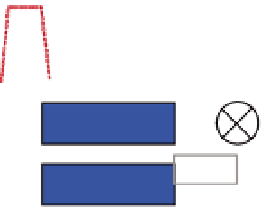Global Positioning System Reference
In-Depth Information
3.2 Frequency-domain unambiguous processing
Frequency-domain processing techniques are represented by sideband techniques. Sideband
technique considers the received BOC signal as the sum of two BPSK signals with carrier
frequency symmetrically positioned on each side of the BOC carrier frequency. Thus each
side lobe is treated independently as a BPSK signal, which provides an unambiguous
correlation function and a wider S-curve steady domain.
The earliest sideband technique was described in (Fishman & Betz, 2000). As shown in
Figure 6, the single sideband technique uses only one of the sidebands (either upper or
lower) of BOC modulated signal. Both the received signal and the local BOC modulated
baseband signal are filtered. Only the upper or lower sidebands of the received and local
signals are retained. The shape of the correlation function of these two filtered signals is
close to that of two BPSK-R signals. Therefore this correlation function can be used instead
of BOC ACF in acquisition and tracking. The double sideband technique uses both the
upper and lower sideband of BOC modulated signal. These two sidebands are processed
separately before the output of correlators, and then the correlation values are added non-
coherently. Compared with single sideband technique, double sideband technique suffers
lower non-coherent correlation losses. However, it requires twice the sideband-selection
filter number of single sideband technique.
Upper Sideband Processing
BOC spectrum
f
Upper
Sideband Filter
Noncoherently
combination
Received
BOC signal
I&D
Local
BOC signal
Upper
Sideband Filter
Lower Sideband Processing
Fig. 6. Block diagram of sideband technique
BPSK-like method (Martin et al., 2003) is another frequency-domain unambiguous
processing technique. This method is also based on the consideration of the BOC spectrum
as the sum of two BPSK spectrum shifted by ±
f
s
. The main difference compared with the
method described above is the fact that only one low-pass filter is employed for the received
signal. As shown in Figure 7, the filter bandwidth includes the two principal lobes of the
spectrum. Another difference is that, the local signal is not the filtered BOC-modulated
baseband signal but the BPSK-R signal, shifted by the sub-carrier frequency
f
s
. The BPSK-
like technique can also be either single or double sideband, according to whether both the
sidebands are used and combined non-coherently or only one sideband is used.
The original BPSK-like method can only be used for sine-phased BOC modulations with
even BOC order. In (Burian et al., 2006), a modified version of BPSK-like method is
proposed to extend BPSK-like method to BOC signals with odd order.




























Search WWH ::

Custom Search